New Japan–CIMMYT Project Hunts for Genes to Fight Disease
June, 2004
No single strain of wheat, barley, or related species completely withstands Fusarium Head Blight, a disease that is making increasing inroads on health and harvests worldwide. A new project offers better methods and broader gene pools for finding genes to ward off the disease.
Fusarium Head Blight (FHB), one of the most destructive wheat diseases in warm and humid regions, seriously threatens wheat and barley production around the world. Even worse, the toxins produced by Fusarium fungus cause acute food poisoning in people and harm animals that eat infected grain.
A new five-year-long collaborative project between CIMMYT and the government of Japan aims to discover genes that control FHB resistance, identify wheat germplasm that can be used in FHB resistance breeding programs, and develop FHB resistant wheat by using DNA markers.
Scientists in Japan began conducting genetic and breeding studies on FHB resistance in the 1960s, after an epidemic swept across more than 400,000 hectares in 1963 and caused estimated yield losses of more than 50%. More recent epidemics in 1996 and 1998 affected about 26% of the land in Japan. Developing countries also suffer losses from FHB, and CIMMYT started its own breeding program on FHB resistance about 20 years ago.
In the United States, FHB is the worst plant disease to emerge since the 1950s, according to the United States Department of Agriculture. In the 1990s, epidemics in seven US states caused more than US$ 1 billion in crop losses. Partly due to climate changes caused by global warming and the increased use of reduced tillage practices, FHB has become more widespread in recent years.
Sources of resistance to the disease have been elusive. Researchers have never found an accession of wheat, barley, or their wild relatives that is completely immune to FHB, according to Tomohiro Ban, a scientist at Japan International Research Center for Agriculture Sciences. A lack of good sources of resistance and good methods for finding them prompted the government of Japan to fund the new project with CIMMYT, which Ban is now leading at CIMMYT-Mexico.
The genetic constitution and chromosomal location of FHB resistance genes are not well known, but current research suggests that several quantitative trait loci or minor genes control resistance. DNA markers could identify and evaluate these genes. It is hoped that the project’s search for resistance genes will also advance because of access to CIMMYT’s genebank, which has one of the world’s largest collections of wheat and its wild relatives. Researchers will be able to screen materials from a great diversity of gene pools and environments.
“We are going to use the untapped potential of these diverse genetic resources and find new sources of resistance,” says CIMMYT Director General Masa Iwanaga. Even more important, the program could become the focus for a more organized worldwide effort to combat the disease. “We would like to facilitate a platform for international collaboration, because this is a global problem,” comments Iwanaga.
For information: Tomohiro Ban
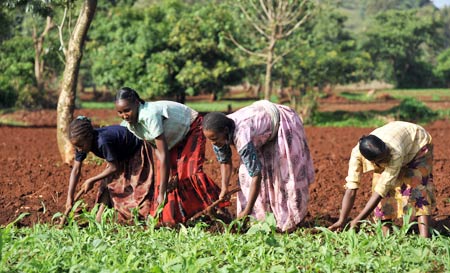 Bold Initiative Tackles Hunger in Developing World
Bold Initiative Tackles Hunger in Developing World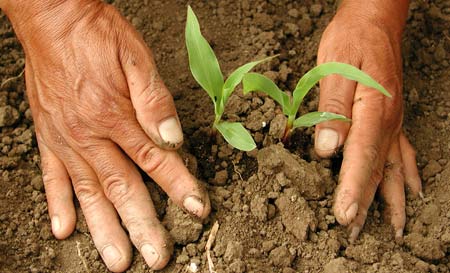 The
The 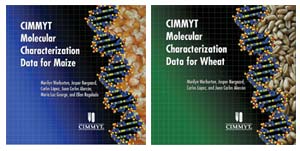 In November CIMMYT unveiled a significant addition to the field of DNA fingerprinting for wheat and maize. Two databases, fashioned by molecular geneticist Marilyn Warburton and her team, are the largest public information sites of their kind.
In November CIMMYT unveiled a significant addition to the field of DNA fingerprinting for wheat and maize. Two databases, fashioned by molecular geneticist Marilyn Warburton and her team, are the largest public information sites of their kind.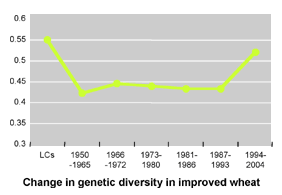 Maize database: http://staging.cimmyt.org/english/docs/manual/dbases/contents_mz.htm
Maize database: http://staging.cimmyt.org/english/docs/manual/dbases/contents_mz.htm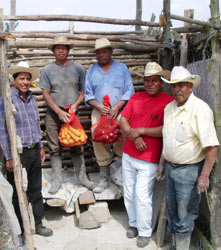 The State of Mexico borders the country’s capital, Mexico City—a potential market of nearly 20 million inhabitants—but farmers there have struggled to make a profit growing maize. CIMMYT is working to help them, as part of a new partnership between the US Department of Agriculture (USDA) and the Mexican Agriculture Secretariat (SAGARPA).
The State of Mexico borders the country’s capital, Mexico City—a potential market of nearly 20 million inhabitants—but farmers there have struggled to make a profit growing maize. CIMMYT is working to help them, as part of a new partnership between the US Department of Agriculture (USDA) and the Mexican Agriculture Secretariat (SAGARPA). Years of low prices, until recently, for maize grain have discouraged farmers from investing in advanced practices or new varieties. “The state of Mexico accounts for ten percent of national maize production, but improved varieties occupy little more than a tenth of its maize area,” says CIMMYT maize researcher Silverio García. “And nearly all the maize they produce is white grained and ideal for local foods, but fails to meet market standards for large-scale, commercial tortilla production, feed or industrial uses.”
Years of low prices, until recently, for maize grain have discouraged farmers from investing in advanced practices or new varieties. “The state of Mexico accounts for ten percent of national maize production, but improved varieties occupy little more than a tenth of its maize area,” says CIMMYT maize researcher Silverio García. “And nearly all the maize they produce is white grained and ideal for local foods, but fails to meet market standards for large-scale, commercial tortilla production, feed or industrial uses.”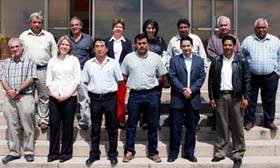 Atlin and Garcia recently led a workshop of 11 maize scientists from the Mexican National Institute of Forestry, Agriculture, and Livestock Research (INIFAP), Mexico State’s Institute of Agriculture, Livestock, Water, and Forestry Research and Training (ICAMEX), the Colegio de Postgraduados (a graduate-level agricultural research and learning institution), and CIMMYT to plan project activities. Participants contributed detailed information on varieties grown in the state, agreed on common software for managing and analyzing data from trials, and discussed ways to foster farmer participation.
Atlin and Garcia recently led a workshop of 11 maize scientists from the Mexican National Institute of Forestry, Agriculture, and Livestock Research (INIFAP), Mexico State’s Institute of Agriculture, Livestock, Water, and Forestry Research and Training (ICAMEX), the Colegio de Postgraduados (a graduate-level agricultural research and learning institution), and CIMMYT to plan project activities. Participants contributed detailed information on varieties grown in the state, agreed on common software for managing and analyzing data from trials, and discussed ways to foster farmer participation.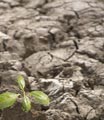 They often have few options other than to obtain their food and income from agriculture. Achieving food security is the incentive for many to allocate a disproportionately large part of their land to maize, leaving little area to other crops such as legumes or cash crops. Human malnutrition and soil degradation are frequent and few escape the “poverty trap.”
They often have few options other than to obtain their food and income from agriculture. Achieving food security is the incentive for many to allocate a disproportionately large part of their land to maize, leaving little area to other crops such as legumes or cash crops. Human malnutrition and soil degradation are frequent and few escape the “poverty trap.”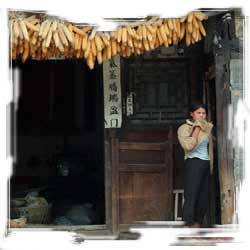 The demand for maize in Asia is expected to skyrocket in the next two decades, driven primarily by its use for animal feed. In the uplands of seven Asian countries, however, demand is also increasing in the farming households who eat the maize crops they grow. CIMMYT and the
The demand for maize in Asia is expected to skyrocket in the next two decades, driven primarily by its use for animal feed. In the uplands of seven Asian countries, however, demand is also increasing in the farming households who eat the maize crops they grow. CIMMYT and the 
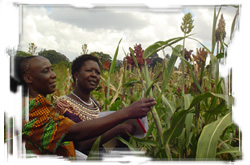 African maize farmers who will grow transgenic maize varieties resistant to one of the crop’s most damaging pests—the maize stem borer—learn that to keep borers at bay, some must survive.
African maize farmers who will grow transgenic maize varieties resistant to one of the crop’s most damaging pests—the maize stem borer—learn that to keep borers at bay, some must survive.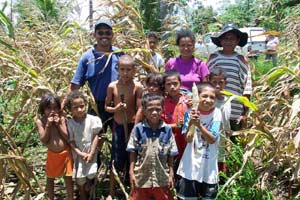 After almost 450 years of foreign occupation, East Timor became the world’s newest country when it declared independence in May 2002. Facing a host of hurdles as it rebuilds destroyed towns and damaged infrastructure, one thing the country lacks is productive and well-adapted germplasm for major crops.
After almost 450 years of foreign occupation, East Timor became the world’s newest country when it declared independence in May 2002. Facing a host of hurdles as it rebuilds destroyed towns and damaged infrastructure, one thing the country lacks is productive and well-adapted germplasm for major crops. Almost 800,000 people live in East Timor, which was once a Portuguese colony. The BBC estimates that about 25% of the population died during Indonesia’s occupation, which began after Portugal withdrew in 1975 and lasted until 1999. After citizens voted for independence, anti-independence militia killed hundreds of people and destroyed towns and already poor infrastructure.
Almost 800,000 people live in East Timor, which was once a Portuguese colony. The BBC estimates that about 25% of the population died during Indonesia’s occupation, which began after Portugal withdrew in 1975 and lasted until 1999. After citizens voted for independence, anti-independence militia killed hundreds of people and destroyed towns and already poor infrastructure.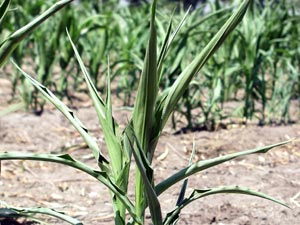 This growing season in south-central Kenya has been a good test for the new drought tolerant maize varieties being bred in Africa. This is a semi-arid area, but this year they can drop the semi. Farmers report only three short periods of rain since the February planting time.
This growing season in south-central Kenya has been a good test for the new drought tolerant maize varieties being bred in Africa. This is a semi-arid area, but this year they can drop the semi. Farmers report only three short periods of rain since the February planting time. A new study from CIMMYT describes some of the effects of the North American Free Trade Agreement (NAFTA) on Mexican maize and wheat farmers, and their creative and resilient responses.
A new study from CIMMYT describes some of the effects of the North American Free Trade Agreement (NAFTA) on Mexican maize and wheat farmers, and their creative and resilient responses.